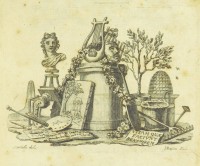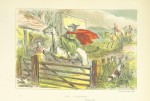 The British Library has released more than one million high resolution images scanned from public domain books from the 17th, 18th and 19th centuries on their Flickr account. Scanned as part of a digitization collaboration with Microsoft that began in 2008, the images illustrate a vast range of topics from literary classics like Charles Dickens novels to anthropological studies, travel guides, histories, song collections, children’s books and ever so much more. Even those decorative swirls that separate chapters and fancy initial capitals made the cut.
The British Library has released more than one million high resolution images scanned from public domain books from the 17th, 18th and 19th centuries on their Flickr account. Scanned as part of a digitization collaboration with Microsoft that began in 2008, the images illustrate a vast range of topics from literary classics like Charles Dickens novels to anthropological studies, travel guides, histories, song collections, children’s books and ever so much more. Even those decorative swirls that separate chapters and fancy initial capitals made the cut.
Each image is tagged by author, date of publication and book title, so if opening one picture inspires you to see every other image in the book, say, just click the link at the bottom of the description and you’ll see them all. Another link at the bottom of the description will show you every image in the collection published that year. That’s just the beginning, though. Starting next year, the British Library will tap into crowd powder to add details, new classifications and, hopefully, research inspirations.
We plan to launch a crowdsourcing application at the beginning of next year, to help describe what the images portray. Our intention is to use this data to train automated classifiers that will run against the whole of the content. The data from this will be as openly licensed as is sensible (given the nature of crowdsourcing) and the code, as always, will be under an open licence.
The manifests of images, with descriptions of the works that they were taken from, are available on github and are also released under a public-domain ‘licence’. This set of metadata being on github should indicate that we fully intend people to work with it, to adapt it, and to push back improvements that should help others work with this release.
There are very few datasets of this nature free for any use and by putting it online we hope to stimulate and support research concerning printed illustrations, maps and other material not currently studied. Given that the images are derived from just 65,000 volumes and that the library holds many millions of items.
 Since the images are public domain, they can be used without conditions. At the very least it’s a huge free stock collection that I can envision coming in very handy for everyone from graphic designers to parents looking to make an extremely nerdy coloring book for their kids (or themselves; coloring is the best). The British Library wants to know how people are using the pictures and they’ve offered their enthusiastic collaboration with any project readers may devise. You can Email or tweet them with any questions or ideas.
Since the images are public domain, they can be used without conditions. At the very least it’s a huge free stock collection that I can envision coming in very handy for everyone from graphic designers to parents looking to make an extremely nerdy coloring book for their kids (or themselves; coloring is the best). The British Library wants to know how people are using the pictures and they’ve offered their enthusiastic collaboration with any project readers may devise. You can Email or tweet them with any questions or ideas.